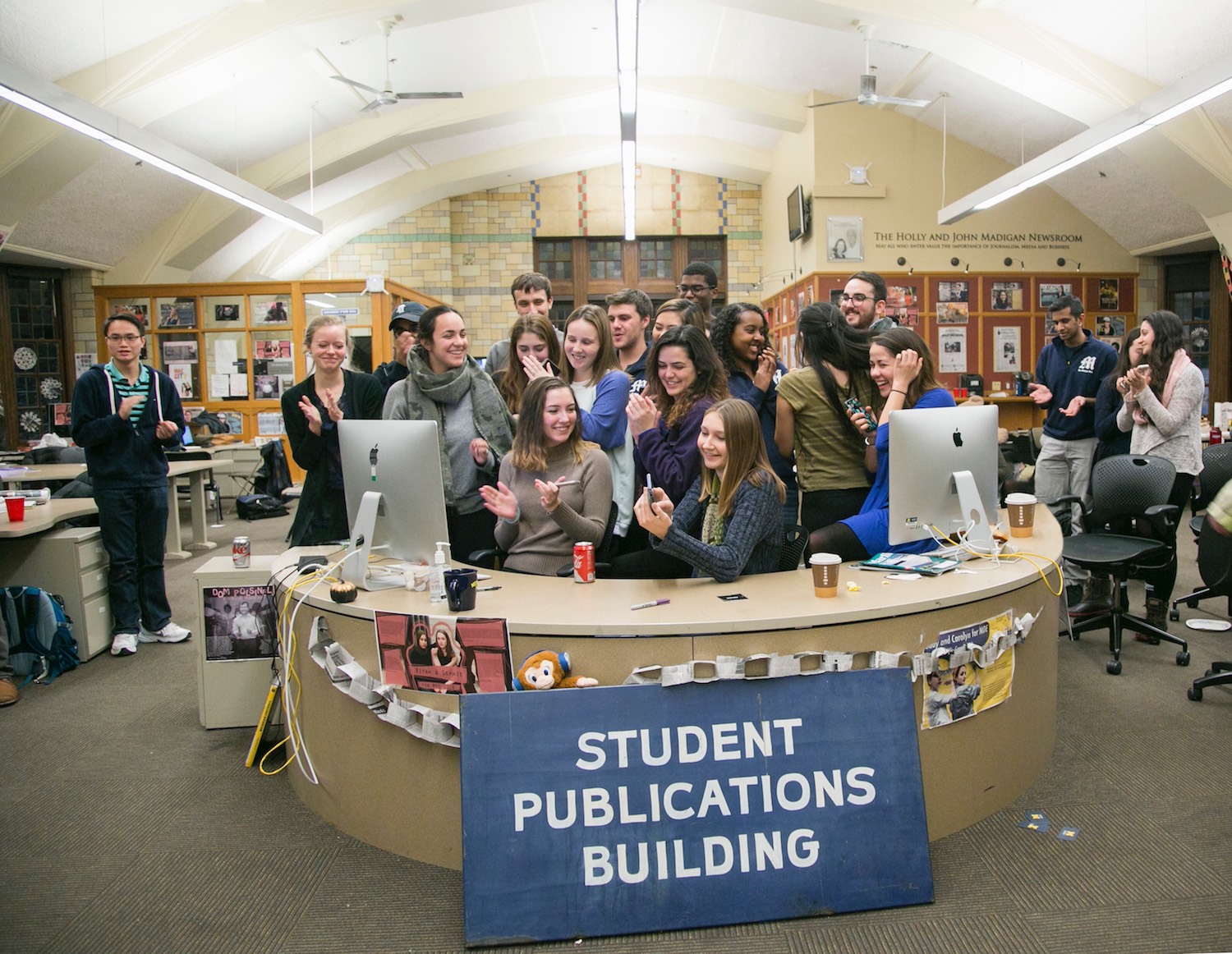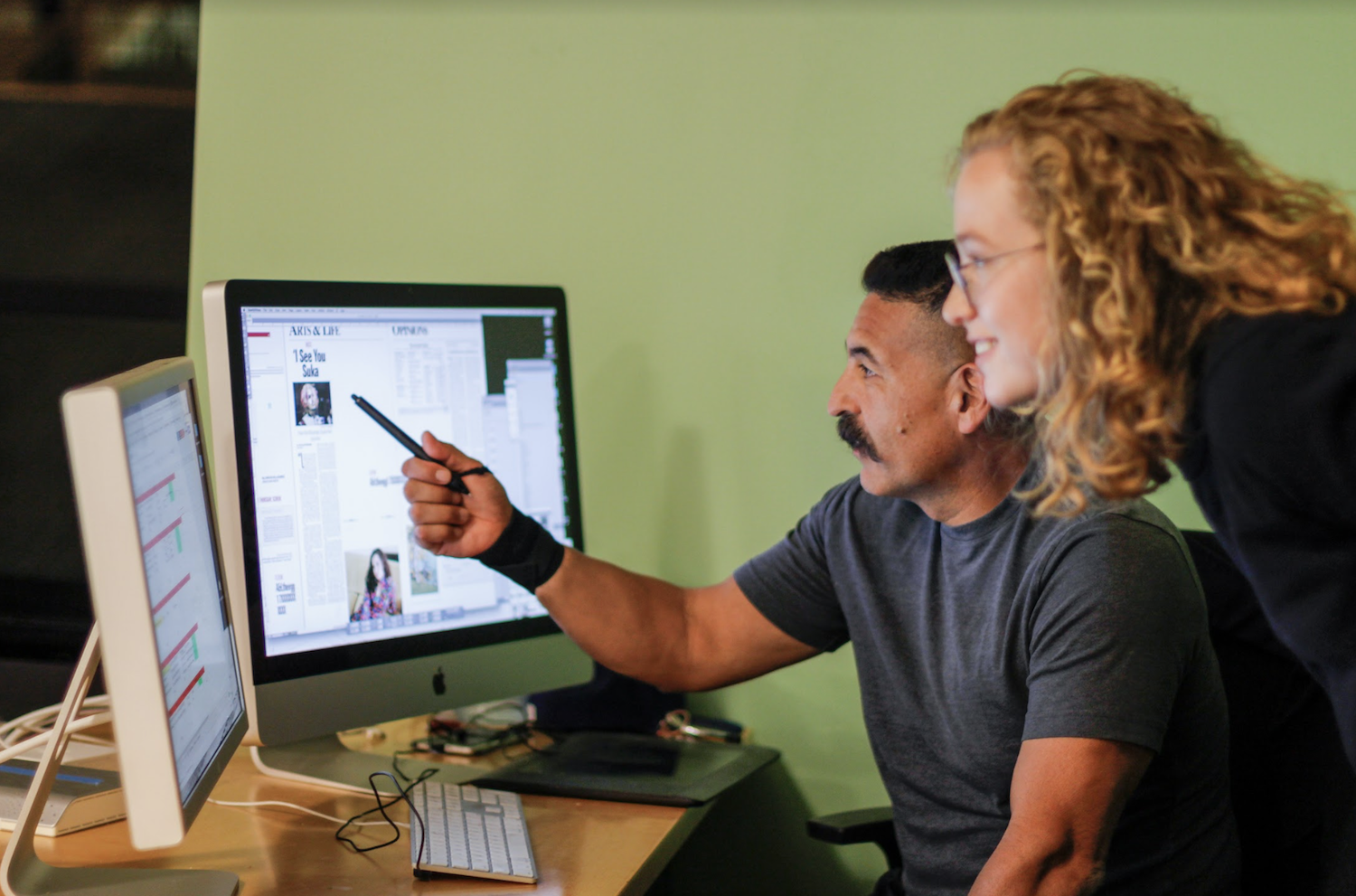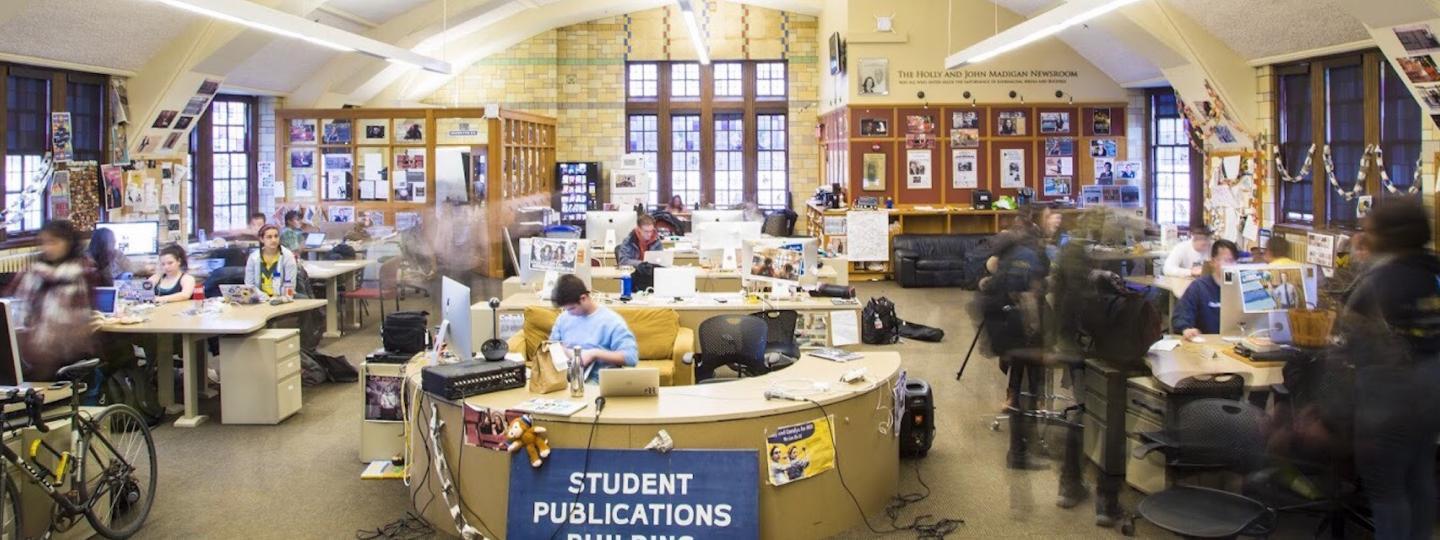When the University of Oklahoma announced it had hired a new president in March, the student-run Oklahoma Daily broke the news ahead of the Norman Transcript.
The Daily, an independent student publication with a staff of 60, prints twice per week but publishes online 24/7. The Norman Transcript, the local newspaper, still publishes in print daily, but with a total staff of 15.
Editors at both agree the two publications keep each other on their toes in covering Norman, Oklahoma — especially in their coverage of OU. They’re covering the same topics for different audiences, and they compete for scoops. When a former professor was accused of sexual harassment, both publications broke news and built on each other’s reporting, Transcript editor-in-chief Caleb Slinkard said.
But it’s a symbiotic relationship; Slinkard teaches a class in OU’s journalism school and stops by the student newsroom when he’s on campus. The Daily is printed at the Transcript’s press, and staffers from the Daily frequently intern at the Transcript.
“The OU Daily is very much a competitor,” Slinkard said. “We take them very seriously and they do a great job. We don’t like being scooped by them, and in our minds, they’re a professional organization.”
The loss of advertising revenue has led to continuing layoffs and cutbacks in local newsrooms. More than 1,800 U.S. newspapers have closed or merged since 2004, according to research from the University of North Carolina’s Center for Innovation and Sustainability in Local Media.
Hundreds of those that remain have been sold to private investors, which “operate with a short-term, earnings-first focus and are prepared to get rid of any holdings — including newspapers — that fail to produce what they judge to be an adequate profit,” according to a previous UNC report.
But in smaller towns like Norman, thriving student publications are filling in gaps in local coverage. As both journalists and participants in the university community, student reporters are uniquely positioned to get inside information on campus happenings — and some, like the Daily, are putting more resources into covering their cities.
“We’ve realized that because OU is the biggest employer in Norman, what we’re writing about the college impacts the wider Norman community,” said Kayla Branch, incoming Oklahoma Daily editor-in-chief. “We’ve started to capitalize on that for our benefit of upping readership and community engagement, but also informing as many people as we can about what’s important to them.”

Increasing local coverage
The student-run Michigan Daily in Ann Arbor, Michigan, is the most frequent print publication in Washtenaw County. The Ann Arbor News closed in 2009 after 174 years of publication and was replaced by a twice-weekly print publication and AnnArbor.com, an online news site. In 2013, the MLive Media Group, owned by Advance Publications, rebranded the print edition as the Ann Arbor News.
The Daily prints five days per week during the school year, and its staff of nearly 200 reporters take the responsibility of local coverage seriously, editor-in-chief Alexa St. John said.
Covering Ann Arbor is a natural fit, she said, because a lot of the issues important to students, like immigration policy, affordable housing and policing, also affect the broader community. The Daily has increased its coverage of city council and put effort into maintaining a relationship with the Ann Arbor community, because a large portion of their print papers get distributed across the city.
“We believe it would be irresponsible if we didn’t cover all those issues in a way that provides context and the full scope of what’s happening,” St. John said. “We try to extend every campus issue we can and connect that to what’s going on in the greater area.”
In Chapel Hill, North Carolina, the Daily Tar Heel at the University of North Carolina has increased its local news coverage since McClatchy shut down the Chapel Hill News in May 2017.
Last school year, the Daily Tar Heel took on more complex city topics, including housing developments in Chapel Hill, the K-12 school system and public safety, incoming editor-in-chief Rachel Jones said.
“We’re the main news source for our community, and it needs to be covered. Chapel Hill does so much for the state and impacts so many people,” Jones said. “Especially in recent years, we’ve tried to emphasize our city coverage as well as our university coverage, and also do more accountability reporting in our university coverage.”
Two reporters from the nearby Raleigh News & Observer and the Durham Herald-Sun cover Chapel Hill and Orange County full-time, but at least a dozen more spend time there as part of their beats, News & Observer executive editor Robyn Tomlin said in an email. The Daily Tar Heel staff has around 30 editors and 100 to 150 reporters during the school year, Jones said.
The News & Observer and Herald-Sun cover North Carolina’s entire Research Triangle region but serve much broader audiences, Tomlin said, including those with no connection to UNC. The Daily Tar Heel can delve deeper into the university and Chapel Hill because of its narrower focus.
“Student publications keep our reporters on their toes,” Tomlin said in an email. “When they break something, we give them credit and then do our best to both amplify and add context to their work. We believe it’s great for the community to have multiple sources of information about the issues that affect their lives.”
Benefits
Students can gain access to university sources and events that are harder for local outlets. The Michigan Daily got access to a closed Greek life meeting about allegations of hazing and assault in fraternities after receiving a tip from fellow students, St. John said.
Then there’s the sheer number of students who work for student publications, which gives them a larger breadth of coverage. All the students interviewed in this piece said editors and some staffers are paid at their publications, but most receive a stipend rate that’s not necessarily equivalent to the hours dedicated to the job.
The Stanford Daily in Palo Alto, California, has a dozen managing editors and more than 100 consistent writers, outgoing editor-in-chief Hannah Knowles said. The Daily has dedicated more reporters to covering local news and arts to supplement its focus on covering Stanford.
Editors have scaled back routine campus event coverage, Knowles said, to free up resources to focus more on Palo Alto and reach local readers. Half of the Daily's print copies are distributed off campus.
“It’s a great opportunity for college papers to fill in gaps where other papers don’t have the resources,” Knowles said.
One potential solution for local news and student newsrooms: partnering rather than competing.
Northwestern University graduate students at the Medill School of Journalism work for the Medill News Service, where students cover Chicago communities for publication in several local outlets. A group of University of Maryland students worked with the USA Today Network this spring to experiment with audience engagement strategies on nontraditional platforms like LinkedIn.
There’s a lot of potential for student journalists to cover their communities in partnership with local outlets, said Stefanie Murray, director of the Center for Cooperative Media. The center’s mission is to strengthen local journalism in New Jersey with a focus on collaborative journalism.
New Jersey news outlets worked with students from Montclair State University, Rutgers and the College of New Jersey in a project last fall to host neighborhood dinner parties with voters ahead of the election for the state’s governor. For a successful partnership, it’s important that there’s an exchange of value on both sides, Murray said.
“For local organizations, it could be really beneficial to have the fresh perspective and students to cover the local community,” she said. “Students hopefully pick up great skills on how to report and listen to the local community.”

Challenges
While students have clear advantages in terms of resources, they’re also still just students — they juggle journalism with classes, part-time jobs and other extracurriculars. It’s hard to motivate student reporters at the University of Georgia to dig deeper into stories when they’re so busy, incoming Red and Black editor-in-chief Erin Schilling said.
“It’s really hard to get the motivation to dig deeper and not have lazy reporting,” Schilling said. “Even if they’re motivated, students are doing so much at one time it’s hard to perfect their articles.”
Constant turnover is another challenge. When students are only at a student publication for four years at most, it’s hard to compete with local beat reporters who have years of experience and sourcing.
The staff of the Athens Banner-Herald in Athens, Georgia, was cut from about 30 to 10 in the last decade and was sold to GateHouse in 2017, but the remaining reporters still have more background knowledge and context on city issues, Schilling said.
“Student reporters get caught up in the stuff that’s new to them and not new to the community,” Schilling said. “We try to curb that mentality where everyone thinks they’ve discovered something.”
Student newsrooms haven’t been immune from the financial challenges facing local newsrooms, especially declining print advertising revenue. Some have been forced to sacrifice their financial independence to stay afloat.
The #SaveStudentNewsrooms campaign highlighted challenges these publications face after Southern Methodist University’s paper, the Daily Campus, reaffiliated with the university because of a lack of funding. More than 100 student newsrooms published editorials about the importance of student media and called for alumni donations on April 25 as part of a national day of action.
And while collaboration can help with shared resources and tight budgets, students shouldn’t just be used as free labor, Murray cautioned, because their work has value. Local outlets should also be aware that students have different levels of experience and their work will typically require more editing.
Partnerships don’t just have to be reporting projects, she said. Forming an agreement to publish each other’s photos or stories with credit could help in areas where resources are thin.
“There’s benefits on both sides, but I would caution against anyone assuming students covering the local community is an answer to fill the gaps we see and help with local news deserts popping up,” she said. “If there’s a reporter or editor at a local publication who worked with students regularly and could onboard, mentor and coach them, that could be the long term beneficial relationship that could help both sides.”
In Norman, the Daily and Transcript haven’t formally collaborated on a project, but they share sources and would be interested in collaborating if an opportunity came up, Branch said.
“There are stories all around college towns and communities that would benefit from a collaborative approach between local and student newspapers, and I think there is a lot that could be gained from a project like that on both sides,” Branch said.
Correction: An earlier version of this story said the Ann Arbor News no longer published in print. It began publishing a print edition twice per week in 2009. We apologize for the error.







